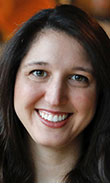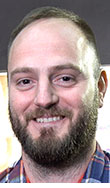Grad Vizzers create animated shorts with Disney Pixar pros

“I think the finished films are remarkable; comparable to animation shorts being produced anywhere."
— Richard Davison

Check out
interview with Vizzer alumna and Pixar pro Sarah Beth Eisenger ’13.

See interview with Jon Kiker, Pixar lighting technical director and 2008 MS-Viz grad.
During a summer-long workshop known for testing the mettle of Texas A&M graduate visualization students, four teams, mentored by visiting artists from Disney’s [Pixar Animated Studios] (https://www.pixar.com/#pixar-home) , crafted short animated films featuring the comedic exploits of dissimilar kitchen robots.
Now in its 18
th
year, the Department of Visualization’s Summer Industry Workshop squeezes a real-world animated film production pipeline into demanding 10-week project. Led through each step of the production projects by a series of visiting experts from nationally acclaimed studios like Disney, Dreamworks and ILMxLAB, the student teams are tasked with creating engaging
[animated shorts]
(http://one.arch.tamu.edu/news/2014/9/9/short-films-under-dreamworks/)
around a central theme.
“This course is a giant commitment for students and there are very high expectations of them, demonstrated by the results of previous years,” said Richard Davison, associate head of the Department of Visualization, who managed last summer’s course and served as a project producer, facilitating interaction between the students and visiting experts. “By virtue of having top industry professionals involved directly, we confidently expect world class results.”
Like the pros do
The class, he said, helps visualization students, know at Texas A&M as Vizzers, prepare to work in the competitive, fast-paced entertainment industry in an accelerated, creative, and labor-intensive environment. Working in teams of four or five, students must wear multiple hats as they create a story, build a detailed digital environment, model their characters, add special effects, details, lighting, and music, all while animating the short. Along the way, they quickly master new software and solve problems.
This year students started with a theme provided by Pixar — “two robots in some kind of kitchen who experience an emotional change.”
The teams came up with “The Spy Who Bugged Me,” a tale of a tiny robot fly trying to steal a secret recipe while evading a wily security bot; “Robo Roll,” where two hapless chefs in a food truck accidentally create a new type of food; “Midnight Snack,” in which two robots compete to serve a healthy or junk food-based snack; and “Fruit Danube,” a story of a fruit-cutting robot who attempts to use anti-gravity to make his job more fun.
Expert input
In addition to the visiting industry pros, Pixar artists in California supported workshop students in all stages of the process, from story development to final cut, via weekly videoconferences. The visiting pros, whose expertise matched a particular stage of the animation’s development, traveled to College Station to provide students a full week of hands-on mentoring.
Two of the experts, Sarah Beth Eisenger ’13, an effects technical director, and Jon Kiker ’05, a lighting technical director, were Texas A&M graduates. As fellow Vizzers, they shared career advice with the aspiring animators determined to follow in their footsteps.
Additional Pixar artists included Adam Schnitzer, layout artist; Guilherme Jacinto, directing animator; and Dan Nguyen, character animator.
“All of the artists are so great to work with and are so personable,” said Vizzer Emily Bujnoch of Hallettsville, production lead for the “ [Robo Roll] (https://www.youtube.com/watch?v=qWIgwXOgq_8) ” team. “They helped us focus on honing our characters, their physicalities, and how they act or react. They have a lot of insight on what feels right and how to fix things.”
In one such tip, Bujnoch’s team turned to the real world to make their animation look realistic. For a scene where a robot drops a can on a food truck floor, they filmed a can of yams crashing to the ground to help them animate its bounce and roll.
“It was such a smart suggestion,” she said. “Having the film as a reference, we could make the animation look believable as a real can and not just a computer-generated one. The mentors would also act out things for us — how to catch things or how someone might fumble something. It was really fun.”
The visitors were similarly impressed with the Vizzers.
“I’m continuously blown away at how creative the students are,” said Eisenger, who came for a special effects-focused week. “One of the teams wanted to create the effect of rain pelting a window and didn’t know how. We opened up Houdini (a 3-D animation software) and worked it out. They are really quick to catch on to how the interface works and that kind of quick thinking and learning is key in a studio.”
Worth the work
The students’ end products were four of the most advanced and creative films seen in the Summer Industry Workshop’s history, according to Davison.
“In several decades of teaching, I have not seen a group of students who were as collectively rock steady, even relentless in their pursuit of quality in these projects,” he said. “I think the finished films are remarkable; comparable to any animation shorts being produced anywhere. I expect them to enter their works in a variety of exhibits and competitions and win.”
Vizzers said they came away from the workshop with more technical skills, a standout piece of work for their reel, insight into the inner workings of the animation industry, connections with potential employers, and a better eye for animation and design.
“I learned a lot of things I wasn’t good at before,” said Jack Clifford, modeling lead for the Fruit Danube team. “I wasn’t confident in my animation skills at all, but after having two experts out here, I’ve gotten a lot better at it. I gained skills I wasn’t actively trying to learn just by being on this team. The pressure encourages you to learn fast.”
Sarah Wilson
swilson@arch.tamu.edu
Tags
- archone gallery
- art
- class acts
- coa gallery
- college culture
- diversity
- graduate work
- interdisciplinary
- rss
- studio projects
- video
- visualization
- viz gallery
Related Posts

Grad vizzers create virtual reality games with ILMxLAB’s help

Disney pro teaches viz students in summer workshop
Grad vizzers create films with guidance from DreamWorks

Viz-a-GoGo 19 slated May 3-5 in Bryan
Follow Us
Facebook Twitter Vimeo Youtube Flickr RSS
Recent Posts

Planning prof heads study of disaster housing aid

A message from the dean

Former student remembered as expert planner

Leading educator named new head of Architecture Dept.













_thumbnail_small.png)
